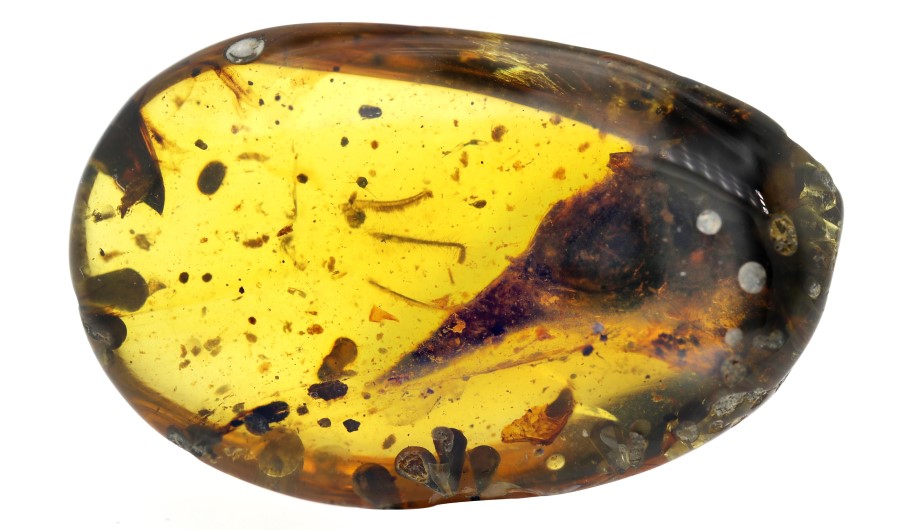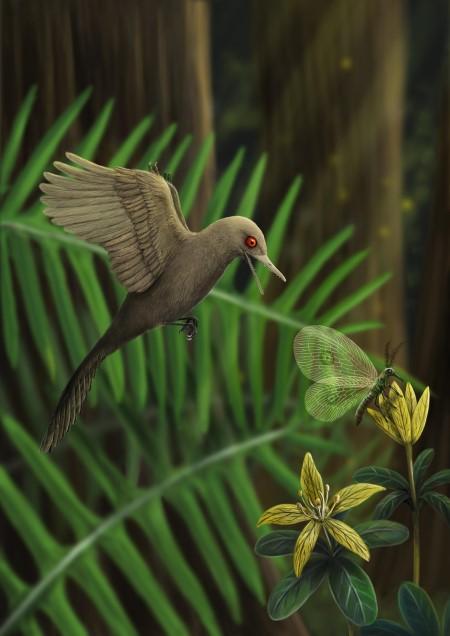New Hummingbird-Sized Dinosaur Identified from Skull Trapped in Amber

Amber with Oculudentavis skull inside.
Lida Xing
(Inside Science) -- A hummingbird-sized dinosaur identified from a skull trapped in amber may be the smallest dinosaur from the Age of Reptiles unearthed yet, a new study finds.
Scientists investigated a tiny, exceptionally well-preserved birdlike skull found in amber that a miner excavated from the Angbamo site in the tropical jungles of northern Myanmar's Hukawng Valley in 2016. Radioisotope dating of zircon crystals in the amber from this site suggests it was roughly 99 million years old.
The skull is only 7.1 millimeters long -- slightly more than a quarter inch. This makes this newfound species the smallest known dinosaur of the Mesozoic Era, or the Age of Reptiles, and only a smidgen larger than the bee hummingbird, the smallest living bird. (Since birds are the last surviving dinosaurs, the bee hummingbird is technically the smallest known dinosaur.)
The scientists named the new species Oculudentavis khaungraae -- Oculudentavis meaning "eye teeth bird" in Latin and khaungraae in honor of Khaung Ra, the woman who donated the specimen to the Hupoge Amber Museum in China. Amber from Myanmar has recently yielded many extraordinary fossils, including hatchling birds, baby snakes and lice hidden in dinosaur feathers.
It remains difficult to estimate how large Oculudentavis was overall, given that the researchers currently only know it from one skull. Still, "I would guess a 5- to 7-centimeter wingspan, 5 to 6 centimeters long and weighing less than an ounce," said study co-lead author Jingmai O'Connor, a vertebrate paleontologist at the Institute of Vertebrate Paleontology and Paleoanthropology in Beijing.
Size may be where the similarities between Oculudentavis and hummingbirds end, O'Connor said. For instance, whereas hummingbirds have evolved to feed on nectar by dipping long thin toothless beaks into flowers, Oculudentavis' jaws "bear numerous teeth, more than any other bird," she noted. Each jaw would have possessed up to 30 sharp teeth, revealing the dinosaur was a predator that likely fed on insects. "The teeth are also fused into the skull, probably to reinforce them, given its small size," she added.
In addition, this dinosaur had eyes "unlike any bird," O'Connor said. "The conical shape is similar to owls, but the eye bones are shaped like a lizard's and not like a bird's." Furthermore, unlike modern predatory birds whose eyes face forward, providing binocular vision, the eyes of Oculudentavis faced to the side and bulged out of the head.
The narrow opening at the center of Oculudentavis' eye socket would have let in only a small amount of light, suggesting the dinosaur was active during the day.
All in all, "the bird is very weird, and it reveals a previously unknown ecology," O'Connor said. "It was a tiny bird with really good vision but vision different from any living bird, so we don't know really what it was like," she explained. Moreover, "it was a tiny predatorial bird, an ecology that does not exist anymore and that we never had known about previously."
Other fossils preserved in amber at the site include lizards, snakes, frogs, other birds, small dinosaurs, insects, plants and nautiluslike ammonites, which indicate close proximity to the sea. The area may have been a tropical mangrovelike environment.
This discovery "shifts our ideas about body size evolution in birds -- they got smaller earlier than we thought," O'Connor said. When evolution drives animals to miniaturize, it often does so on islands and other isolated environments, and the miniature nature of Oculudentavis is consistent with previous suggestions that this amber formed on an island in an archipelago within the now-vanished Tethys Sea, the researchers said.
"We all know that there are a lot of small and even tiny vertebrates alive today -- fishes, frogs, lizards and birds in particular," said Darren Naish, a vertebrate paleontologist at the University of Southampton in England, who did not take part in this research. "My impression has always been that these absurdly small sizes are a novelty of geologically recent times and that they hadn't evolved prior to, say, 35 million years ago or so. But, no -- this amazing fossil shows that such miniature vertebrates were present during the Cretaceous at least."
Naish added the absence of such tiny animals from the fossil record is probably because they simply did not survive the ravages of time. "It's amazing, and really makes you wonder what else we've missed in the world of Mesozoic miniature vertebrates," he said.
It remains uncertain how exactly Oculudentavis is related to other dinosaurs, but the researchers suggested its lineage began diverging from other birds around 150 million years ago, Naish said. "Oculudentavis is about 99 million years old, meaning that its lineage potentially existed for around 50 million years. This is an exciting prospect, since it means that there could have been numerous species of these hummingbird-sized early birds existing over an unknown area for much of the Cretaceous and perhaps part of the Jurassic."
In the future, the scientists hope to analyze soft tissues trapped in the amber by developing new techniques that work nondestructively, "since the specimens are so rare and priceless," O'Connor said. "Right now, the study of vertebrates in amber is just scratching the surface."
The scientists detailed their findings in the March 12 issue of the journal Nature.


